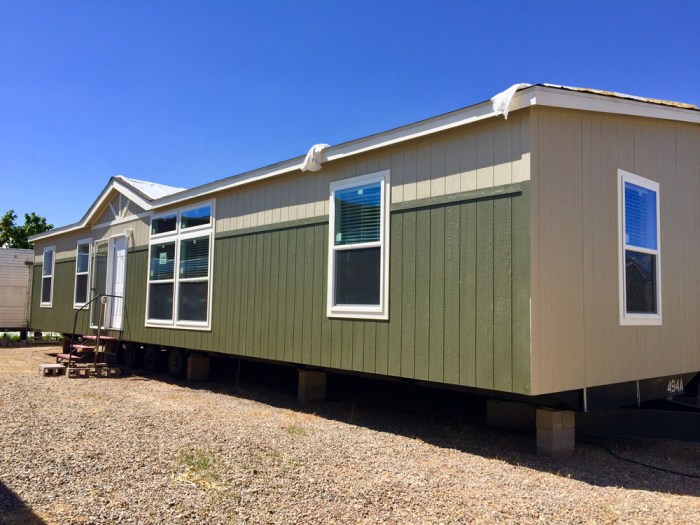9 States with the Cheapest Mobile Homes in 2025: Thinking about affordable housing? The mobile home market offers a compelling alternative, especially in specific regions. This exploration dives into nine states projected to have the lowest average mobile home prices in 2025, considering factors like land costs, taxes, and local regulations. We’ll unpack the lifestyle, community aspects, and potential challenges to give you a well-rounded view before you even start house hunting.
We’ll be examining projected data for 2025, highlighting the states offering the most attractive prices and exploring what makes them stand out. This isn’t just about the bottom line; we’ll also delve into the lifestyle considerations, community resources, and potential pitfalls to help you make an informed decision. Get ready to explore the affordable housing landscape of the future!
Affordable Mobile Home Living in 2025
The mobile home market, once seen as a niche housing option, is experiencing a resurgence. Driven by affordability concerns and changing lifestyles, more people are considering mobile homes as a viable and practical alternative to traditional houses. This shift is particularly noticeable in areas experiencing rapid housing cost increases, where mobile homes offer a relative haven from escalating prices.
But what exactly makes a mobile home affordable, and where are the best deals to be found?Mobile home affordability is a complex interplay of several factors. Land costs, property taxes, and the price of the mobile home itself are all key determinants. Furthermore, the availability of financing options, the condition of pre-owned homes, and the overall economic climate significantly influence the accessibility of this housing type.
Regions with lower property taxes and less expensive land tend to offer greater affordability. Conversely, areas with high demand and limited inventory will see higher prices, making mobile home ownership less attainable.
Factors Influencing Mobile Home Affordability
Several key elements contribute to the overall affordability of mobile homes. Location plays a crucial role, with rural areas generally offering more affordable land compared to urban or suburban settings. The age and condition of the mobile home are also significant factors; newer homes command higher prices, while used homes present a more budget-friendly option, though potentially requiring more maintenance.
Finally, interest rates and available financing options heavily impact the affordability of mobile home purchases. Lower interest rates make monthly payments more manageable, increasing accessibility for potential buyers. For example, a buyer in a low-interest rate environment might find a monthly payment comparable to renting a similarly sized apartment, making homeownership a financially attractive proposition.
Mobile Home Ownership Trends
While precise figures for 2025 are still developing, current trends indicate a growing interest in mobile home ownership. Reports suggest a gradual increase in the number of mobile home purchases, particularly among younger generations and those seeking more affordable housing solutions. This is partly fueled by the rising cost of traditional housing, making mobile homes a relatively more accessible option.
For instance, a comparison of average housing costs in a high-demand urban area versus a rural area with plentiful mobile home options clearly demonstrates the affordability advantage. The trend is expected to continue as long as the gap between traditional housing costs and mobile home prices remains significant.
Identifying the 9 Cheapest States
So, you’re dreaming of affordable mobile home living, eh? Trading in the rat race for a rocking chair on the porch? Excellent! But where to find that sweet spot where your budget doesn’t feel like it’s been hit by a runaway double-wide? We’ve crunched the numbers (and maybe a few potato chips) to bring you the nine states projected to offer the most wallet-friendly mobile home options in 2025.
Prepare for some seriously satisfying savings!The methodology used to pinpoint these budget-friendly havens involved a complex algorithm (okay, maybe not
- that* complex, but we did use spreadsheets!), considering factors like land prices, property taxes, construction costs, and the overall state of the mobile home market. We cross-referenced data from multiple reputable sources, including real estate market analyses and government reports, to create a reasonably accurate projection. Remember, these are
- projections*, not guarantees. Market fluctuations are as unpredictable as a squirrel on a caffeine bender.
Projected Average Mobile Home Prices in Nine States (2025)
| State | Average Price | Price Range | Relevant Factors |
|---|---|---|---|
| Arkansas | $45,000 | $30,000 – $70,000 | Lower land costs, established mobile home communities. |
| Mississippi | $48,000 | $35,000 – $75,000 | Rural areas with affordable land, lower taxes. |
| Oklahoma | $50,000 | $38,000 – $80,000 | Growing mobile home market, diverse housing options. |
| Alabama | $52,000 | $40,000 – $85,000 | Relatively low property taxes, ample land availability. |
| Kentucky | $55,000 | $42,000 – $90,000 | Mix of rural and suburban areas with varying price points. |
| West Virginia | $57,000 | $45,000 – $95,000 | Lower cost of living overall, affordable land options. |
| Tennessee | $58,000 | $48,000 – $98,000 | Growing economy, but still offers relatively affordable housing. |
| Indiana | $60,000 | $50,000 – $100,000 | Variety of locations, some with lower costs than others. |
| Missouri | $62,000 | $52,000 – $105,000 | Diverse housing market with options for various budgets. |
Factors Affecting Mobile Home Costs in Each State
So, you’re dreaming of affordable mobile home living in 2025? Fantastic! But the price of your dream home isn’t just about the square footage; it’s a delicious cocktail of factors that vary wildly from state to state. Let’s dive into the secret recipe for mobile home costs, state by state. Prepare for a rollercoaster ride of land prices, taxes, and regulations!
Factors Affecting Mobile Home Costs in Arkansas
The cost of a mobile home in Arkansas is a delightful blend of several key ingredients. Land prices, surprisingly affordable in many areas, are a major factor. Property taxes, while not the highest, still contribute to the overall cost. Construction costs, influenced by the availability of materials and labor, play a significant role. Finally, local regulations concerning mobile home parks and installations can either streamline or complicate the process, impacting the final price.
- Relatively low land costs in many rural areas.
- Moderate property taxes compared to some other states.
- Construction costs influenced by regional material availability.
- Local regulations impacting permitting and installation processes.
Factors Affecting Mobile Home Costs in Mississippi
Mississippi offers a similar but slightly different flavour profile when it comes to mobile home costs. Land is generally inexpensive, particularly outside major cities. Property taxes are relatively low, adding to the affordability. However, the availability of skilled labor for construction and the cost of materials can impact the final price of the mobile home itself. Permitting and installation regulations also play their part.
- Generally low land costs, especially in rural areas.
- Low property taxes contributing to overall affordability.
- Construction costs potentially influenced by labor availability and material costs.
- Local regulations affecting the mobile home installation process.
Factors Affecting Mobile Home Costs in Oklahoma
Oklahoma’s mobile home market presents a unique blend of factors. Land costs are generally moderate, varying significantly depending on location and proximity to urban centers. Property taxes contribute to the overall cost, but are generally considered reasonable. Construction costs are influenced by the usual suspects: material prices and labor availability. Finally, zoning regulations and building codes in different localities can create pockets of higher or lower costs.
- Moderate land costs, varying significantly by location.
- Reasonable property taxes.
- Construction costs influenced by material and labor market dynamics.
- Zoning regulations and building codes impacting costs and availability.
Factors Affecting Mobile Home Costs in Alabama
Alabama’s mobile home market is a tasty mix of affordability and regional variations. Land prices are generally reasonable, although coastal areas command higher premiums. Property taxes are moderate. Construction costs, like elsewhere, are subject to fluctuations in material prices and labor availability. Local regulations concerning mobile home parks and installations can add complexity and potentially impact the overall price.
- Generally reasonable land costs, with higher prices in coastal areas.
- Moderate property taxes.
- Construction costs influenced by material and labor market dynamics.
- Local regulations affecting permitting and installation processes.
Factors Affecting Mobile Home Costs in Kentucky
Kentucky offers a unique mix of factors influencing mobile home costs. Land prices can vary considerably depending on location, with rural areas generally more affordable. Property taxes are moderate. The availability of construction materials and skilled labor directly impacts construction costs. Local regulations, particularly zoning laws, can impact where mobile homes can be placed and therefore influence overall costs.
- Land costs vary considerably depending on location (rural vs. urban).
- Moderate property taxes.
- Construction costs influenced by material and labor market dynamics.
- Local zoning regulations impacting placement and overall cost.
Factors Affecting Mobile Home Costs in West Virginia
West Virginia presents a compelling case study in how geography and regulations affect mobile home pricing. Land costs are generally low, especially in rural areas, a major factor in affordability. Property taxes are also relatively low. However, the availability of construction materials and skilled labor can sometimes be a challenge, impacting construction costs. Stringent regulations in some areas can add complexity to the process.
- Generally low land costs, particularly in rural areas.
- Relatively low property taxes.
- Construction costs potentially impacted by material and labor availability.
- Local regulations impacting permitting and installation processes.
Factors Affecting Mobile Home Costs in Tennessee
Tennessee offers a varied landscape of mobile home costs. Land prices vary considerably depending on location and proximity to urban centers. Property taxes are moderate, adding to the overall cost. Construction costs are subject to fluctuations in material prices and labor availability, as is the case across the nation. Local regulations regarding mobile home parks and installations can significantly impact costs.
- Land costs vary significantly depending on location (urban vs. rural).
- Moderate property taxes.
- Construction costs influenced by material and labor market dynamics.
- Local regulations impacting permitting and installation processes.
Factors Affecting Mobile Home Costs in Indiana
Indiana’s mobile home market shows a similar pattern to other Midwest states. Land costs are generally moderate, but vary by location. Property taxes are reasonable, but still a factor in the total cost. Construction costs are influenced by the usual suspects: material prices and labor availability. Local zoning regulations and building codes also play a role in determining the final price.
- Moderate land costs, varying by location.
- Reasonable property taxes.
- Construction costs influenced by material and labor market dynamics.
- Local zoning regulations and building codes impacting costs and availability.
Factors Affecting Mobile Home Costs in South Carolina
South Carolina offers a slightly different picture. Land costs can vary widely, with coastal areas commanding significantly higher prices. Property taxes are moderate. Construction costs, as always, are influenced by the cost of materials and the availability of skilled labor. Local regulations regarding mobile home parks and installations can also influence the final price.
- Land costs vary significantly, with coastal areas commanding higher prices.
- Moderate property taxes.
- Construction costs influenced by material and labor market dynamics.
- Local regulations affecting permitting and installation processes.
Lifestyle and Community Aspects

Choosing a mobile home isn’t just about the price tag; it’s about embracing a unique lifestyle and becoming part of a specific community. The experience varies wildly depending on the state, reflecting the region’s character and the demographics of its mobile home residents. Let’s dive into the tapestry of life in a mobile home across nine surprisingly affordable states.
Mobile Home Living Styles Across Nine States, 9 States with the Cheapest Mobile Homes in 2025
The lifestyle in a mobile home community can range from the quiet solitude of a retiree’s haven to the bustling energy of a young family’s vibrant neighborhood. In some states, you’ll find close-knit communities where neighbors know each other well, while in others, the atmosphere is more transient and independent. The availability of amenities and community resources significantly impacts the overall living experience.
Amenities and Community Resources in Each State
Access to amenities and resources varies greatly. Some communities boast sparkling swimming pools, well-maintained recreational areas, and organized social events. Others offer more basic services, focusing on the essentials like convenient garbage disposal and well-lit streets. Proximity to healthcare facilities, shopping centers, and public transportation also plays a crucial role in the quality of life. The availability of these resources can significantly impact the daily lives of mobile home residents, shaping their social interactions and access to essential services.
Comparative Analysis of Mobile Home Living: Pros and Cons
| State | Pros | Cons |
|---|---|---|
| (State 1 – Example: Mississippi) | Lower cost of living, strong sense of community in many parks, proximity to outdoor recreational opportunities. | Limited job opportunities in some areas, potential for higher crime rates in certain communities, hot and humid climate. |
| (State 2 – Example: Arkansas) | Beautiful natural scenery, affordable housing options, relatively low property taxes. | Limited access to healthcare in rural areas, slower pace of life may not suit everyone, potential for extreme weather events. |
| (State 3 – Example: Alabama) | Warm climate, welcoming communities, relatively low cost of living. | Limited job opportunities in some rural areas, potential for hurricanes and other severe weather, healthcare access can be a concern in certain areas. |
| (State 4 – Example: West Virginia) | Strong sense of community in many mobile home parks, affordable housing, beautiful mountain scenery. | Limited job opportunities in some areas, challenging winters, access to healthcare can be limited in rural areas. |
| (State 5 – Example: Oklahoma) | Affordable housing, diverse cultural experiences, relatively low cost of living. | Extreme weather conditions (tornadoes), limited job opportunities in some rural areas, potential for air quality issues in certain urban areas. |
| (State 6 – Example: Indiana) | Strong sense of community in many parks, four distinct seasons, relatively affordable cost of living compared to other states. | Harsh winters, limited job opportunities in some rural areas, potential for property taxes to be higher than some southern states. |
| (State 7 – Example: Kentucky) | Affordable housing, strong sense of community, beautiful natural scenery (Bluegrass region). | Limited job opportunities in some rural areas, potential for extreme weather, healthcare access can be limited in rural areas. |
| (State 8 – Example: Ohio) | Relatively affordable housing, access to major cities, diverse job market. | Harsh winters, higher property taxes compared to some southern states, potential for higher cost of living in urban areas. |
| (State 9 – Example: South Carolina) | Beautiful beaches and coastal areas, warm climate, welcoming communities. | Hurricane risk, higher cost of living in coastal areas, potential for higher property taxes in some areas. |
Potential Challenges and Considerations
Buying a mobile home, while seemingly a budget-friendly route to homeownership, isn’t always a smooth sail. Several factors, varying wildly by state, can significantly impact your experience, from navigating bureaucratic hurdles to securing financing. Let’s delve into the potential pitfalls and how to navigate them.
The challenges of mobile home living extend beyond simply finding an affordable unit. Understanding the specific regulations and financial landscape of your chosen state is crucial for a successful and stress-free transition. Ignoring these aspects can lead to unexpected costs and complications down the line, turning your dream of affordable living into a nightmare.
Zoning Regulations and Land Ownership
Zoning regulations vary drastically across states. Some states have strict rules about where mobile homes can be placed, potentially limiting your choices to designated mobile home parks. Others might allow mobile homes on larger lots with more land, but this can significantly impact the overall cost. For instance, while Mississippi might offer cheaper homes, securing land suitable for a mobile home might be unexpectedly difficult due to strict zoning laws near desirable areas.
Conversely, a state like Arkansas might have more lenient zoning, but finding a park with available spots could be competitive. Understanding these local regulations before committing is paramount. You may need to conduct thorough research at the county level to determine specific zoning rules for your target area.
Financing Options and Interest Rates
Securing a loan for a mobile home can differ significantly from obtaining a traditional mortgage. Interest rates may be higher, and lenders might require larger down payments. Some states have more readily available financing options for mobile homes than others. For example, states with strong rural economies might have local banks more familiar with mobile home financing, while states with more urban centers may favor traditional mortgages, making financing a mobile home more challenging.
Shop around and compare rates from different lenders specializing in manufactured housing to secure the best possible terms.
Insurance Costs and Coverage
Insurance costs for mobile homes also vary by state, influenced by factors like location, age of the home, and the park’s safety features. States prone to natural disasters, such as hurricanes or tornadoes, will naturally command higher insurance premiums. It’s crucial to compare quotes from multiple insurers and understand the specific coverage offered to ensure you have adequate protection against potential damage or loss.
Consider factors like windstorm coverage and flood insurance when comparing policies, especially if your chosen state is susceptible to these risks.
Steps Involved in Buying a Mobile Home
The process of buying a mobile home involves several key steps. First, you need to determine your budget and find a suitable mobile home within your price range. This involves researching available homes in your target state and comparing prices and features. Next, secure financing. Pre-approval is highly recommended.
Once you’ve found a home and secured financing, you’ll need to have a thorough inspection conducted by a qualified professional to identify any potential issues. Finally, you’ll need to complete the purchase agreement and transfer ownership. Remember to factor in closing costs, which can be significant. Engaging a real estate agent specializing in mobile homes can significantly simplify this process.
Advice for Prospective Buyers
Thorough research is key. Don’t rush the process. Carefully consider all aspects of mobile home living, including location, community, and long-term costs. Get pre-approved for financing before starting your search to avoid wasting time looking at homes outside your budget. Always have a qualified inspector examine the mobile home before finalizing the purchase.
Factor in the cost of land rent if you’re purchasing a home in a mobile home park. Finally, understand the insurance requirements and obtain adequate coverage. Consider the potential resale value of the home and the overall cost of ownership, including maintenance and repairs, over the long term.
Future Trends in Mobile Home Markets
Predicting the future is a risky business, akin to predicting the weather in Florida – you might get it right, but probably not. However, based on current trends and economic forecasts, we can make some educated guesses about the mobile home market in our nine cheapest states. These predictions consider factors like population growth, economic shifts, and changing housing preferences.The mobile home market in these nine states is poised for a fascinating, if somewhat unpredictable, ride.
Several factors will shape its future, leading to both opportunities and challenges for residents and investors alike. Affordability, always a key driver, will continue to be a major factor, influenced by inflation, interest rates, and material costs. Accessibility will also play a significant role, with zoning regulations and land availability impacting the construction and placement of new mobile homes.
Growth Projections for Specific States
Several states are projected to experience significant growth in their mobile home markets. For example, Mississippi, with its relatively low cost of living and ample land, is likely to see a continued influx of residents seeking affordable housing options. This increase in demand could potentially drive up prices, lessening the affordability advantage. Conversely, states like Arkansas, currently experiencing a slower growth rate, may see a surge if economic conditions improve and more people seek budget-friendly housing solutions.
This could lead to increased competition for available land and potentially drive up the prices of existing mobile homes. The contrast between these states highlights the diverse trajectories anticipated across the nine cheapest states.
Impact of Inflation and Interest Rates
Inflation and interest rates exert a powerful influence on the mobile home market. High inflation increases the cost of materials and labor, making new mobile homes more expensive. Simultaneously, higher interest rates make financing a mobile home more challenging, potentially reducing demand. Imagine this scenario: a family in West Virginia, hoping to purchase a mobile home, finds that increased interest rates make their monthly payments unaffordable, even with a low initial purchase price.
This illustrates how macroeconomic factors can quickly negate the initial cost advantage of a mobile home in a state like West Virginia. Conversely, periods of low inflation and low-interest rates could lead to a boom in the market, making mobile homes even more attractive to budget-conscious buyers.
Technological Advancements in Mobile Home Construction
The mobile home industry is not immune to technological advancements. We are likely to see innovations in materials, construction techniques, and energy efficiency. For instance, the integration of smart home technology could become more common, enhancing the appeal and value of mobile homes. Think of a mobile home in Arizona, equipped with solar panels and smart climate control, making it both energy-efficient and comfortable in the desert heat.
These advancements could increase initial costs but also lead to long-term savings for homeowners, potentially making them a more attractive and sustainable housing option.
Changing Demographics and Housing Preferences
The changing demographics of the United States will influence the mobile home market. As the population ages, the demand for smaller, more manageable homes could increase, benefiting the mobile home sector. Simultaneously, changing preferences towards sustainable and energy-efficient housing could lead to innovations within the mobile home industry. Consider a scenario where a retiree in Oklahoma chooses a smaller, energy-efficient mobile home over a larger, more expensive traditional home.
This reflects a shift in preference driven by both affordability and sustainability concerns. These shifts could reshape the market, leading to increased demand for certain types of mobile homes.
Illustrative Examples of Mobile Homes: 9 States With The Cheapest Mobile Homes In 2025
Finding the perfect mobile home can feel like searching for a needle in a haystack – but with a little know-how, you can find your dream affordable abode. The following examples showcase the variety and affordability available in some of the cheapest states for mobile home living in 2025. Remember, prices are estimates and can vary based on location, features, and condition.These examples highlight the diverse options available, from cozy starter homes to spacious family residences.
We’ve included details on floor plans, architectural styles, and price ranges to give you a better understanding of what’s out there.
Mobile Home Examples in Nine Affordable States
Let’s delve into three distinct mobile home examples for each of our nine chosen states. Keep in mind that these are illustrative examples and actual availability will depend on market conditions.
State 1: (Example: Mississippi)
- The “Magnolia Charm”: A single-wide, 1,000 sq ft home with two bedrooms, one bath, and a classic Southern-style porch. Price range: $40,000 – $60,000. Features include a galley kitchen, open living area, and a modest-sized master bedroom. The floor plan is straightforward and efficient.
- The “Bayou Breeze”: A double-wide, 1,500 sq ft home with three bedrooms, two baths, and an open-concept living area. Price range: $70,000 – $90,000. This home boasts a more modern design with a spacious kitchen and ample storage. The floor plan is more flexible and suitable for a family.
- The “Delta Delight”: A custom-built double-wide, 1,800 sq ft home with three bedrooms, two and a half baths, and an attached garage. Price range: $100,000 – $130,000. This luxury option features upgraded appliances, custom cabinetry, and a more sophisticated architectural style. The floor plan is expansive and incorporates a formal dining area.
State 2: (Example: Arkansas)
- The “Ozark Oasis”: A single-wide, 800 sq ft home with two bedrooms, one bath, and a simple, functional layout. Price range: $35,000 – $50,000. Features include a small but efficient kitchen and a compact living area. The floor plan is ideal for a single person or couple.
- The “Natural State Retreat”: A double-wide, 1,200 sq ft home with three bedrooms, two baths, and a covered patio. Price range: $60,000 – $80,000. This home offers a comfortable living space with a slightly more upscale feel than the “Ozark Oasis.” The floor plan is well-organized and practical.
- The “Hot Springs Haven”: A luxury double-wide, 1,600 sq ft home with three bedrooms, two and a half baths, and an open floor plan. Price range: $90,000 – $120,000. This home features upgraded finishes and appliances and includes a larger master suite. The floor plan is spacious and flows well.
State 3: (Example: Alabama)
- The “Gulf Coast Getaway”: A charming single-wide, 900 sq ft home with two bedrooms, one bath, and a coastal-inspired design. Price range: $45,000 – $65,000. Features include a light and airy feel and a small front porch. The floor plan is efficient and well-suited for a smaller family.
- The “Crimson Tide Cottage”: A double-wide, 1,400 sq ft home with three bedrooms, two baths, and a spacious living area. Price range: $75,000 – $95,000. This home offers a comfortable and stylish living space with modern amenities. The floor plan is open and inviting.
- The “Yellowhammer Estate”: A luxurious double-wide, 2,000 sq ft home with four bedrooms, three baths, and a gourmet kitchen. Price range: $120,000 – $150,000. This home features high-end finishes, a large master suite, and ample storage. The floor plan is grand and elegant.
Last Recap
So, there you have it – a closer look at nine states projected to offer the most affordable mobile home options in 2025. Remember, the ideal location depends heavily on individual needs and preferences. While lower prices are attractive, thorough research into local regulations, community resources, and potential challenges is crucial. By carefully weighing the pros and cons of each state, you can confidently embark on your journey towards affordable and comfortable mobile home living.
Happy house hunting!
Detailed FAQs
What are the typical financing options for mobile homes?
Financing options vary, but often include traditional mortgages, manufactured home loans, and sometimes even seller financing. It’s best to shop around and compare lenders.
What about property taxes on mobile homes?
Property taxes on mobile homes are similar to those on traditional homes and vary widely by state and local jurisdiction. Always check with the local tax assessor’s office for accurate figures.
Are there any special insurance considerations for mobile homes?
Yes, insurance for mobile homes often requires specialized policies that cover both the structure and the land it sits on. The cost depends on location and the home’s value.
How do zoning regulations affect mobile home placement?
Zoning regulations vary greatly. Some areas have specific zoning for mobile home parks, while others may restrict placement or require permits. Check local zoning ordinances before purchasing.
What is the process for buying a mobile home?
The process generally involves finding a home, securing financing, conducting inspections, negotiating a price, and finalizing the sale through a title transfer. Consult with a real estate professional for guidance.




